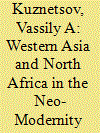| Srl | Item |
| 1 |
ID:
088139


|
|
|
|
|
| Publication |
2009.
|
| Summary/Abstract |
IN THE MIDDLE EAST Russia concentrates, to a great extent, its political-diplomatic efforts at creating a sustainable and reliable security system in the zone (or sub-region) of the Persian Gulf occupied by eight states: Bahrain, Iraq, Iran, Qatar, Kuwait, United Arab Emirates (UAR), Oman and Saudi Arabia. Its mineral wealth - about two-thirds of the world's explored reserves of oil and about one-third of the world's gas reserves - has made it critically important for global economic and energy security.
The current situation that has taken several decades to reach the present stage is best described as permanent instability worsened by repeated crises. The best illustration of many faults of the unipolar world, it was shaped by a series of bloody armed conflicts: the Iran-Iraq war of 1980-1988; the Kuwait crisis and the Desert Storm of 1990-1991 and the 2003 war in Iraq.
Since the early 1980s, the United States has been positioning itself as the main source of stability in the Gulf zone, a sphere of its vital interests.
|
|
|
|
|
|
|
|
|
|
|
|
|
|
|
|
| 2 |
ID:
165656


|
|
|
|
|
| Summary/Abstract |
This article analyzes international relations in Western Asia and North Africa (WANA) amid the ongoing reformatting of the modern world order. The emerging new world order is examined through the transition from post-modernity to neo-modernity. The analysis of theoretical works on post-modernity helps to study the phenomenon of neo-modernity, identify its key features, and compare possible characteristics of the new world order with those of neo-modernity. The second and third parts of the paper explore neo-modernity with regard to WANA. Two options for WANA’s political self-identity and two ways to build a regional system of relations are discussed. One of the options suggests looking at WANA from a modern perspective as the Middle East; the other views it as pre-modernistic and part of the Islamic world. The composition of actors, the role of political narratives,
|
|
|
|
|
|
|
|
|
|
|
|
|
|
|
|